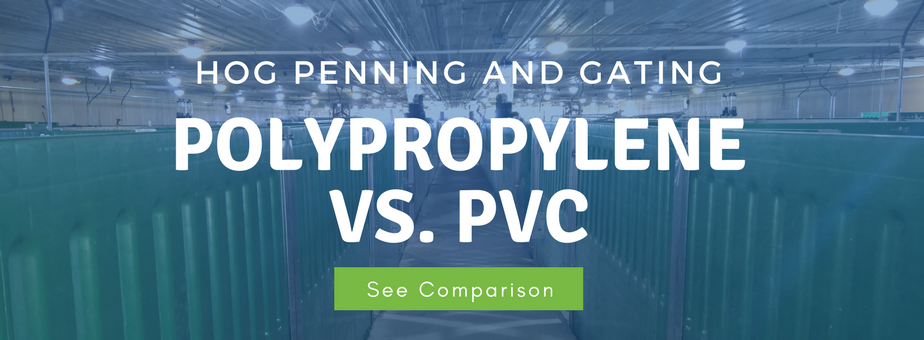.png?width=924&name=A%20Comparison%20of%20Creep%20Penning%20Options_%20(1).png)
One area of production that is all too often overlooked is creep penning. We would argue that some of the most important work of the farm happens in the farrowing room, and the materials used in creep penning can make or break your farrowing unit.
Animals are only in the farrowing unit for a few short weeks and then the unit is washed and turned over to a new batch of sows and piglets. Because of this constant turnover and the biological vulnerability of piglets, having strong biosecurity matters. Your number one resource in maintaining good biosecurity in the farrowing unit is by using creep penning that is easy to sanitize.
There are several options for creep penning and making the decision on a material often comes down to dollars and cents. But the price of the material and installation isn't the only cost involved, you also must consider the cost to your herd.
Below, we've compiled a chart comparing key features of the three main creep penning materials side by side.
.png?width=1024&name=PanelTIM%20(7).png)
PVC
Polyvinyl Chloride, or PVC, is a type of plastic made with carbon, hydrogen and chlorine. It is produced by electrolysis of salt water, which produces chlorine. The chlorine is then combined with ethylene, a byproduct of oil production. This combined mixture, ethylene dichloride, is heated to very high temperatures and then polymerized to make a rigid resin.
One of the main downfalls of PVC, besides being environmentally unfriendly, is the fact that its molecular structure is quite loose, leaving room for bacteria and micro-bacteria to thrive, even when a surface appears clean. The structure of hog pen panels made from PVC is also a potential environmental threat.
Traditionally, hog pen panels made of PVC are made using a series of internal tubes that run through the entire panel. These tubes are open at the ends, leaving plenty of places for dirt, water, and bacteria to collect. These long open runs in each panel have earned a nickname as a “mouse condo” as each level in the panel makes a nice home for mice…or flies, maggots, etc.
PVC is widely available and easy to find, so it is an easy choice for many producers. It is easy to move and manipulate and relatively easy to replace. Panels made of PVC are prone to breakage, especially over time, making them a more temporary solution for most producers. One, we would argue, isn't worth the biosecurity risk.
Galvanized Steel
Galvanized steel creep penning panels are typically made of galvanized sheet metal, bent to give rigidity, strength, and structural integrity. The benefit of these panels is their strength, durability, and ability to maintain rigidity without the needed addition of many posts or supports. Galvanized steel is relatively non-porous and able to be cleaned, however, the nature of the galvanizing is that there is a moderately rough surface that can be difficult to guarantee it is clean.
Steel also bonds more easily with foreign substances such as dirt and bacteria, so scrubbing and the use of high pressure is often required, making cleaning a laborious task for barn workers.
Another downside to steel is its weight. When workers need to lift a panel to move piglets or put in a heat mat, the weight becomes difficult. Steel penning also tends to make the space feel darker because of its light absorption, whereas plastics are typically produced in light colors, allowing for more ambient light refraction in the room.
The major downside of steel, however, is the instability of its cost. Steel creep penning costs vary depending on raw steel prices, whereas the cost of other creep penning options is generally more stable
PanelTIM
PanelTIM is made of polypropylene, one of the most neutral plastics as it is made up of only carbon and hydrogen. It is made primarily of recycled goods and is 100 percent recyclable at the end of its lifespan. The molecular structure of polypropylene is close-knit, making it difficult for foreign substances to bond to. Additionally, because of its highly recyclable nature, polypropylene is one of the most environmentally friendly options on the market.
PanelTIM's square, sealed cells have an internal cell structure of either two or four inches. This ensures that all sides of the panels are always closed, even with customized, made-to-measure, panels. This structure, combined with the smooth, closely bonded molecular structure of the polypropylene, means there is no room for dirt, water or bacteria to collect.
Creep penning made with PanelTIM is also much easier to clean when it is time to roll over the barn. It is light, easy to move, and very durable. Where PVC wears out every couple of years, PanelTIM can last for the conceivable life of the barn.
The strength of PanelTIM comes from its ability to flex slightly under pressure while not breaking. It is an ideal penning material for both creep areas, sow areas, and even boar pens, because of this strength and durability.
So Which Is the Right Choice For My Creep Penning?
Only you can answer that question, but we certainly have an opinion!
PanelTIM is a high-quality product that we recommend for most applications. The durability, cost, weight, and most importantly, biosecurity, make it a phenomenal choice for creep penning and most other barn and agricultural applications.
If you're looking for more information on PanelTIM and the specific differences between PVC and Polypropylene, check out the article below.





